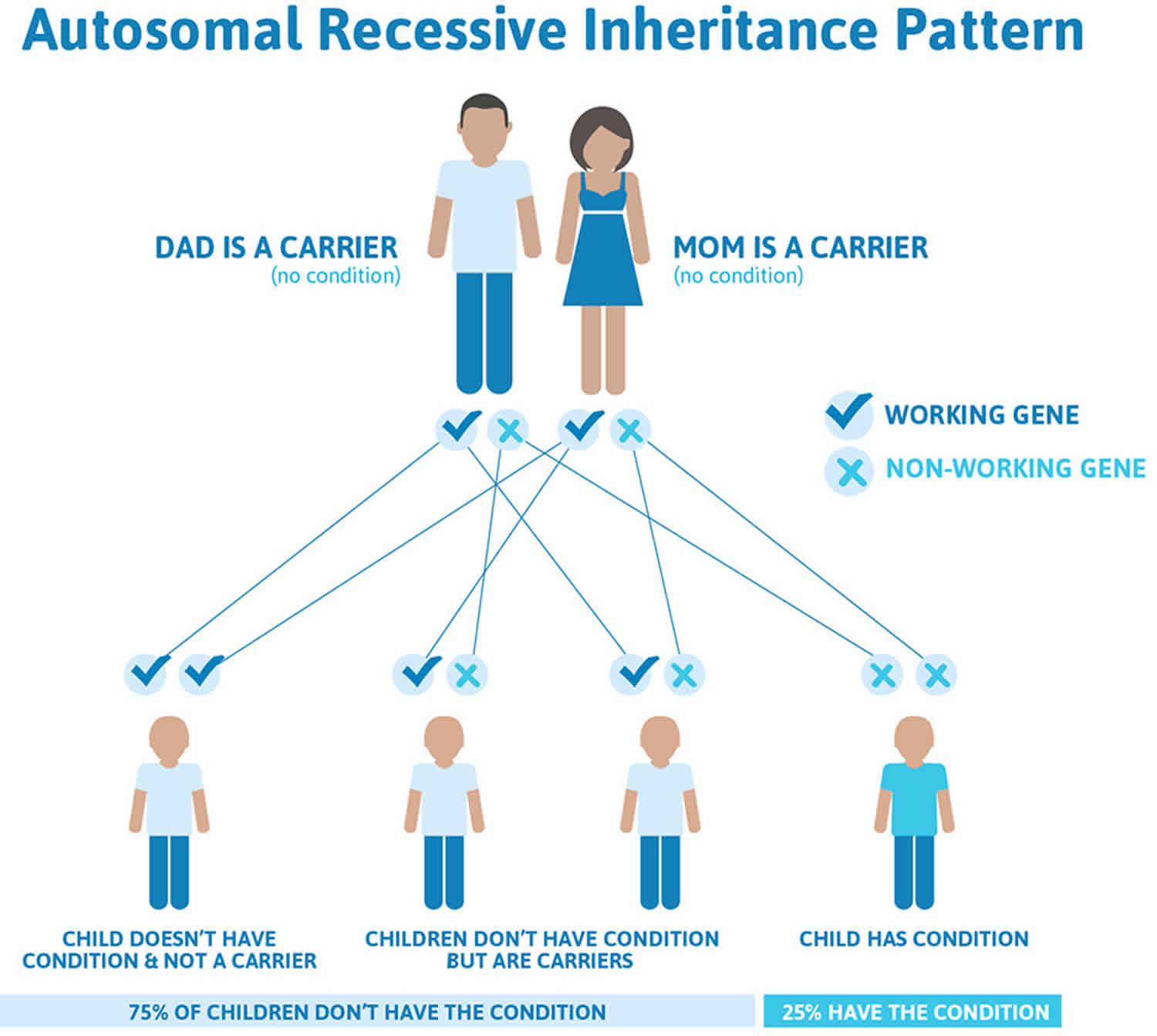What is autosomal recessive
Autosomal recessive means two copies of the abnormal gene, one from each parent (one abnormal gene from mum and one abnormal gene from dad), is needed to cause the disorder or disease. The parents of an individual with an autosomal recessive condition each carry one copy of the mutated gene, but they typically do not show signs and symptoms of the condition. Autosomal recessive disorders are typically not seen in every generation of an affected family. Cystic fibrosis and sickle cell anemia are common examples of an autosomal recessive genetic disorders.
Autosomal refers to the fact that whatever gene is involved is found on one of the first 22 chromosomes (called the autosomes) and not on the X or Y chromosome (the sex chromosomes).
Recessive refers to the explanation above that you need two copies of the abnormal gene, one from mom and one from dad, in order to have a autosomal recessive condition. The copy you inherit from mom is not working AND the copy you inherit from dad is not working, resulting in zero functioning copies of that gene. With autosomal recessive conditions, if you only have one copy of the non-working gene (called a carrier), you do not have the condition and typically do not have any related symptoms.
What does autosomal recessive mean?
This means that a person must inherit two changed copies of the same gene (one abnormal gene from each parent) in order to have the condition. If a person inherits one abnormal gene and one normal gene, then in most cases that person will be a healthy carrier because the normal gene compensates for the abnormal gene. Being a carrier means that you do not have the condition, but carry a changed copy of the gene on one of a pair of genes.
It is rare to see any history of autosomal recessive conditions within a family because if someone is a carrier for one of these conditions, they would have to have a child with someone who is also a carrier for the same condition. Autosomal recessive conditions are individually pretty rare, so the chance that you and your partner are carriers for the same recessive genetic condition are likely low. Even if both partners are a carrier for the same condition, there is only a 25% chance that they will both pass down the non-working copy of the gene to the baby, thus causing a genetic condition. This chance is the same with each pregnancy, no matter how many children they have with or without the condition.
- If both partners are carriers of the same abnormal gene, they may pass on either their normal gene or their abnormal gene to their child. This occurs randomly.
- Each child of parents who both carry the same abnormal gene therefore has a 25% (1 in 4) chance of inheriting a abnormal gene from both parents and being affected by the condition.
- This also means that there is a 75% ( 3 in 4) chance that a child will not be affected by the condition. This chance remains the same in every pregnancy and is the same for boys or girls.
- There is also a 50% (2 in 4) chance that the child will inherit just one copy of the abnormal gene from a parent. If this happens, then they will be healthy carriers like their parents.
- Lastly, there is a 25% (1 in 4) chance that the child will inherit both normal copies of the gene. In this case the child will not have the condition, and will not be a carrier.
These possible outcomes occur randomly. The chance remains the same in every pregnancy and is the same for boys and girls.
Figure 1 illustrates autosomal recessive inheritance. The example below shows what happens when both dad and mum is a carrier of the abnormal gene, there is only a 25% chance that they will both pass down the abnormal gene to the baby, thus causing a genetic condition.
Key points to remember
- A person must inherit two copies of a abnormal gene, one from each parent, in order to be affected by the condition (25% chance). If a person inherits only one abnormal gene then they will be a carrier (50% chance). These outcomes occur randomly. They remain the same in every pregnancy and are the same for boys and girls.
- A abnormal gene cannot be corrected – it is present for life.
- A abnormal gene is not something that can be caught from other people. They can still be a blood donor, for example.
- People often feel guilty about a genetic condition which runs in the family. It is important to remember that it is no-one’s fault and no-one has done anything to cause it to happen.
Figure 1. Autosomal recessive inheritance
Autosomal recessive disorders
Autosomal recessive disorders list
- Achromatopsia
- Arrhythmogenic cardiomyopathy
- Bardet–Biedl syndrome
- Beaulieu‐Boycott‐Innes syndrome
- Bowen‐Conradi syndrome
- Carnitine palmitoyltransferase 1 deficiency
- Cerebellar atrophy, short stature
- Combined pituitary hormone deficiency
- Congenital hyperinsulinism
- Cranioectodermal dysplasia‐like
- Cystic fibrosis
- Dilated cardiomyopathy with ataxia syndrome
- Hurler syndrome
- Hypophosphatasia
- Joubert syndrome related disorder
- Kartagener syndrome
- Leigh disease
- Limb girdle muscular dystrophy 2H
- Limb girdle muscular dystrophy 2I
- Limb girdle muscular dystrophy 2S
- MCAD deficiency (medium-chain acyl-coenzyme A dehydrogenase deficiency)
- McArdle disease (glycogen storage disease type 5)
- Methylmalonic aciduria
- Morquio syndrome (mucopolysaccharidosis type IV)
- Nephronophthisis‐juvenile
- Oculocutaneous albinism type 1A
- Primary Ciliary Dyskinesia
- Sensorineural deafness
- Nonsyndromic mental retardation
- Restrictive dermopathy
- Sanfilippo syndrome (mucopolysaccharidosis type III)
- Segawa syndrome
- Sickle cell anemia
- Sitosterolemia
- Spinal muscular atrophy
- Succinylcholine sensitivity
- TAR syndrome (thrombocytopenia-absent radius syndrome)
- Thyroid dyshormonogenesis I
- Usher syndrome Type 1B
- Usher syndrome Type 1F
- VLDLR with cerebellar hypoplasia
- Xeroderma pigmentosum





